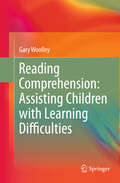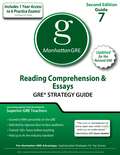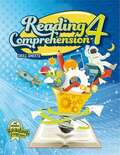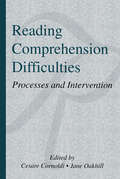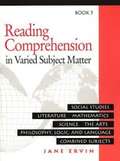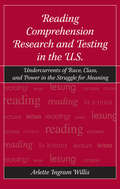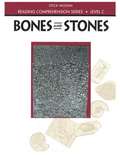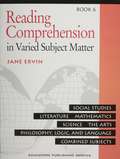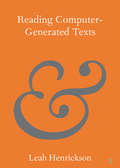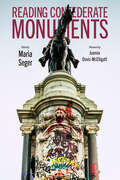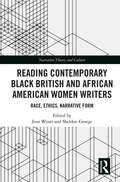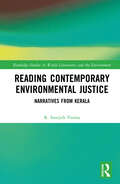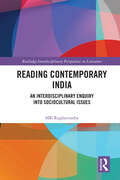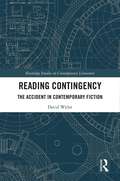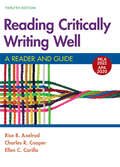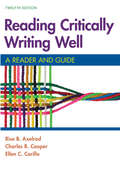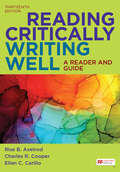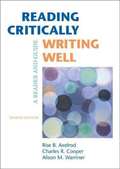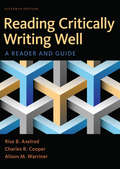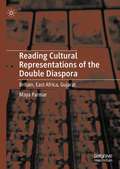- Table View
- List View
Reading Comprehension
by Jean Lisa Mollie Hancock Richert BrittenumThis collection of fascinating readings with follow-up activities is designed to be an effective tool for developing comprehension and vocabulary skills. The follow-up activities encompass such basic skills as author's purpose, fact or opinion, skimming, reading for details, vocabulary, compare/contrast, time sequence, main idea, referents, and many more. An extension activity is also provided with each reading to be used for enrichment or as a "challenge" for those who finish early.
Reading Comprehension
by Gary WoolleyReading Comprehension: Assisting Children with Learning Difficulties examines the complex nature of reading comprehension. It introduces a model for classifying reading comprehension based on an expanded Simple View of Reading. Issues related to assessment, diagnosis, and remediation of reading comprehension difficulties are discussed and translated into clear recommendations to inform reading intervention design and practice. It gives an informed understanding as to why reading comprehension is difficult for some children with learning disabilities such as ADHD, autism, language difficulties and dyslexia. From leading literacy research, the book develops a deeper understanding of thinking processes that facilitate comprehension at the word, discourse, and metacognitive levels. Children will benefit from the introduction of evidence-based methods for teaching reading comprehension using structured multiple-strategy frameworks.
Reading Comprehension & Essays: GRE Verbal Strategy Guide
by The Editors at the Manhattan GREUpdated for the revised GRE, the Reading Comprehension and Essays Guide provides a comprehensive approach to Reading Comprehension passages and questions on the GRE. It contains practical techniques for grasping difficult, unfamiliar content and perceiving passage structure rapidly and will teach you how to attack questions through effective classification and analysis.<P> Each chapter explains core principles and builds fundamental skills through numerous, in-depth examples and exercises. The chapter on Essays equips you to write excellent responses on the Analytical Writing section of the GRE, while handy analytical tools allow you to identify critical flaws in given arguments.
Reading Comprehension 3 Skill Sheets
by Abeka BooksEvaluate your child’s reading comprehension with 36 weekly reading activities with comprehension checks covering a variety of topics including natural resources, weather, research, recipes, flyers, and poems. Each story comes with a specified amount of time in which to read and comprehension questions to answer. The questions and activities are built on literary concepts developed throughout the reading program. Stimulate your child’s reading interest and help them improve their speed and comprehension skill through these informative stories.
Reading Comprehension 4 Skill Sheets
by AbekaThis workbook contains a full year of informative, narrative, and poetic selections designed for silent reading and evaluation. The activity sheets begin with recall questions for optional grading and build to critical thinking questions for recognizing and reinforcing literary concepts. <p><p>With this book, your students will develop essential reading skills and retain the important elements presented within a story.
Reading Comprehension 4: Skills Sheets
by Abeka BooksAssess your child’s reading comprehension skills throughout the year with Abeka’s Reading Comprehension 4 Skill Sheets. Poems, brief stories, and non-fiction passages are paired with activity sheets that give recall and critical thinking questions that will help your child build essential reading skills. Answers are located in the Reading Comprehension 4 Skill Sheets Teacher Edition (sold separately). 88 pages, softcover. Grade 4.
Reading Comprehension Difficulties: Processes and Intervention
by Jane Oakhill Cesare CornoldiRecognizing the characteristics of children with learning disabilities and deciding how to help them is a problem faced by schools all over the world. Although some disorders are fairly easily recognizable (e.g., mental retardation) or very specific to single components of performance and quite rare (e.g., developmental dyscalculia), schools must consider much larger populations of children with learning difficulties who cannot always be readily classified. These children present high-level learning difficulties that affect their performance on a variety of school tasks, but the underlying problem is often their difficulty in understanding written text. In many instances, despite good intellectual abilities and a superficial ability to cope with written texts and to use language appropriately, some children do not seem to grasp the most important elements, or cannot find the pieces of information they are looking for. Sometimes these difficulties are not immediately detected by the teacher in the early school years. They may be hidden because the most obvious early indicators of reading progress in the teacher's eyes do not involve comprehension of written texts or because the first texts a child encounters are quite simple and reflect only the difficulty level of the oral messages (sentences, short stories, etc.) with which the child is already familiar. However, as years go by and texts get more complex, comprehension difficulties will become increasingly apparent and increasingly detrimental to effective school learning. In turn, studying, assimilating new information, and many other situations requiring text comprehension -- from problem solving to reasoning with linguistic contents -- could be affected. Problems with decoding, dyslexia, and language disorders have attracted more interest from researchers than have specific comprehension problems and have occupied more room in specialized journals. Normal reading comprehension has also been a favorite with researchers. However, scarce interest has been paid to subjects who have comprehension difficulties. This book is an attempt to remedy this situation. In so doing, this volume answers the following questions: * Does a reading comprehension problem exist in schools? * How important and widespread is the problem? * Is the problem specific? * How can a reading comprehension difficulty be defined and identified? * Does the "syndrome" have a single pattern or can different subtypes be identified? * What are the main characteristics associated with a reading comprehension difficulty? * When can other well-identified problems add to our understanding of reading comprehension difficulties? * Which educational strategies are effective in preventing and treating reading comprehension difficulties? * What supplementary information can we get from an international perspective?
Reading Comprehension In Varied Subject Matter (Reading Comprehension #Book 5)
by Jane ErvinThis popular series offers nonfiction reading passages with comprehension questions on a variety of subjects for students in second grade through junior high school and beyond. Topics and questions prepare students for standardized tests and provide valuable practice in nonfiction reading comprehension. The entire Reading Comprehension series is particularly useful in a classroom that has students of varying reading abilities. <p><p> Themes such as "Great Americans" and "What Do You Think?" reappear in each book, with the exact focus of the passage changing according to the level of the material. Reading Comprehension Used successfully by classroom teachers, tutors, ESL teachers, and parents, these workbooks have been revised and updated, with the addition of new reading selections, new vocabulary, and a new writing exercise. Each workbook has 31 selections in these subject areas: social studies; science; literature; mathematics; philosophy, logic, and language; the arts; and combined subjects. Each book in this series is arranged thematically. <p> The themes relate the selections to one another, show different aspects of a topic, and give students a broader knowledge of a subject. Each selection follows a consistent format 7-step format in presenting the passage, and includes exercises on vocabulary and writing. Skills Addressed: Story recall; Sequencing; Drawing conclusions; Vocabulary development; Main idea; Extending thoughts in writing; Inference.
Reading Comprehension Research and Testing in the U.S.: Undercurrents of Race, Class, and Power in the Struggle for Meaning
by Arlette Ingram WillisThis book challenges traditional, sanctioned, and official histories of reading comprehension by examining how ideological and cultural hegemony work to reproduce dominant ideologies through education in general and reading comprehension research and testing specifically. Willis analyzes the ideological and cultural foundations that underpin concepts, theories, research, tests, and interpretations, and connects these to the broader social and political contexts within U.S. history in which reading comprehension research and testing have evolved. The reconstruction of a history of reading comprehension research and testing in this way demystifies past and current assumptions about the interconnections among researchers, reading comprehension research, and standardized reading comprehension tests. A promising vision of the future of reading comprehension research and testing emerges–one that is more complex, multidimensional, inclusive, and socially just. Reading Comprehension Research and Testing in the U.S. aims to revolutionize how reading comprehension is conceived, theorized, tested, and interpreted for all children. This is a critically relevant volume for educational researchers, teacher educators, school administrators, teachers, policy makers, and all those concerned with school literacy and educational equity.
Reading Comprehension Series-Level C: Bones and Stones
by Martha K. Resnick Carolyn J. HyattConcentrates on sequentially building vocabulary and comprehension skills.
Reading Comprehension in Varied Subject Matter Book 8
by Jane ErvinThis series has a consistent format that allows students in the same class to use different levels. It builds reading comprehension skills, contextual vocabulary skills, and provides cross-curricular reading practice via content-area topics.
Reading Comprehension in Varied Subject Matter, Book 6 (Reading Comprehension, Erc Mrc Ser.)
by Jane ErvinThis popular series offers nonfiction reading passages with comprehension questions on a variety of subjects for students in second grade through junior high school and beyond.
Reading Comprehension through Novels
by Nancy Bruns WagnerREADING COMPREHENSION THROUGH NOVELS by Nancy Wagner
Reading Computer-Generated Texts (Elements in Publishing and Book Culture)
by Leah HenricksonNatural language generation (NLG) is the process wherein computers produce output in readable human languages. Such output takes many forms, including news articles, sports reports, prose fiction, and poetry. These computer-generated texts are often indistinguishable from human-written texts, and they are increasingly prevalent. NLG is here, and it is everywhere. However, readers are often unaware that what they are reading has been computer-generated. This Element considers how NLG conforms to and confronts traditional understandings of authorship and what it means to be a reader. It argues that conventional conceptions of authorship, as well as of reader responsibility, change in instances of NLG. What is the social value of a computer-generated text? What does NLG mean for modern writing, publishing, and reading practices? Can an NLG system be considered an author? This Element explores such question, while presenting a theoretical basis for future studies.
Reading Confederate Monuments
by Joanna Davis-McElligattContributions by Danielle Christmas, Joanna Davis-McElligatt, Garrett Bridger Gilmore, Spencer R. Herrera, Cassandra Jackson, Stacie McCormick, Maria Seger, Randi Lynn Tanglen, Brook Thomas, Michael C. Weisenburg, and Lisa Woolfork Reading Confederate Monuments addresses the urgent and vital need for scholars, educators, and the general public to be able to read and interpret the literal and cultural Confederate monuments pervading life in the contemporary United States.The literary and cultural studies scholars featured in this collection engage many different archives and methods, demonstrating how to read literal Confederate monuments as texts and in the context of the assortment of literatures that produced and celebrated them. They further explore how to read the literary texts advancing and contesting Confederate ideology in the US cultural imaginary—then and now—as monuments in and of themselves. On top of that, the essays published here lay bare the cultural and pedagogical work of Confederate monuments and counter-monuments—divulging how and what they teach their readers as communal and yet contested narratives—thereby showing why the persistence of Confederate monuments matters greatly to local and national notions of racial justice and belonging. In doing so, this collection illustrates what critics of US literature and culture can offer to ongoing scholarly and public discussions about Confederate monuments and memory. Even as we remove, relocate, and recontextualize the physical symbols of the Confederacy dotting the US landscape, the complicated histories, cultural products, and pedagogies of Confederate ideology remain embedded in the national consciousness. To disrupt and potentially dismantle these enduring narratives alongside the statues themselves, we must be able to recognize, analyze, and resist them in US life. The pieces in this collection position us to think deeply about how and why we should continue that work.
Reading Contemporary Black British and African American Women Writers: Race, Ethics, Narrative Form (Narrative Theory and Culture)
by Jean Wyatt Sheldon GeorgeContemporary African American and Black British Women Writers: Narrative, Race, Ethics brings together British and American scholars to explore how, in texts by contemporary black women writers in the U. S. and Britain, formal narrative techniques express new understandings of race or stimulate ethical thinking about race in a reader. Taken together, the essays also demonstrate that black women writers from both sides of the Atlantic borrow formal structures and literary techniques from one another to describe the workings of structural racism in the daily lives of black subjects and to provoke readers to think anew about race. Narratology has only recently begun to use race as a category of narrative theory. This collection seeks both to show the ethical effects of narrative form on individual readers and to foster reconceptualizations of narrative theory that account for the workings of race within literature and culture.
Reading Contemporary Environmental Justice: Narratives from Kerala (Routledge Studies in World Literatures and the Environment)
by R. Sreejith VarmaThis volume investigates 11 contemporary environmental justice narratives from Kerala, the south-western state in India. Introducing a detailed review of environmental literature in Malayalam, the selected eco-narratives are presented through two key literary genres: life narratives and novels, conveying the socio-environmental pressures, problems, and anxieties of modern, globalising Kerala. This text also entails primary investigations of ‘toxic fictions’ and ‘extractivist fictions,’ including Malayalam novels that narrate the disastrous consequences of the permeation of toxic pollutants in human and ecosystemic bodies, and novels that chronicle the impact of exploitative mining activities on the environment. All eco-narratives analysed in the book exhibit the familiar pattern of the Global South environmental narratives, namely, a close imbrication of the ecological and social spheres. Reading Contemporary Environmental Justice argues that these selected eco-texts offer inspiring scenarios where the subaltern people show thantedam, or courage, to claim thante idam, one’s own space in society and on the Earth. This volume will be essential for those looking to expand their understanding of environmental justice and the harmful effects of development and modernisation.
Reading Contemporary India: An Interdisciplinary Enquiry into Sociocultural Issues (Routledge Interdisciplinary Perspectives on Literature)
by MK RaghavendraThe book is the first ever attempt to examine various sociocultural aspects of contemporary India, ranging from caste and hierarchy and the religious or political conflict resulting from it to literary practice and intellectual life in the public space and making interdisciplinary associations. It does this by going back to various aspects of India’s past, stretching back several millennia to those owing to public policy after independence. Many of the issues today, such as those named above, can be traced to racial mixing through centuries, which has created a multitude of conflicts that need solutions today. The book is divided into separate chapters corresponding to the issues needing addressing, and a brief note at the conclusion of each chapter makes connections with issues dealt in other chapters. The book has an introduction tracing a significant portion of India’s past and an afterword identifying crisis areas in the present.
Reading Contingency: The Accident in Contemporary Fiction (Routledge Studies in Contemporary Literature)
by David WylotIn Reading Contingency: The Accident in Contemporary Fiction, David Wylot constructs an innovative study of the relationship between plotted accidents in twenty-first century British and American fiction, the phenomenology of reading, and a contemporary experience of time that is increasingly understood to be contingent and accidental. A synthesis of literary and cultural analysis, narratology, critical theories of time and the philosophy of contingency, the book explores the accident’s imagination of contemporary time and the relationship between reading and living in novels by writers including A.M. Homes, Nicola Barker, Noah Hawley, J.M. Coetzee, J.G. Ballard, Jesmyn Ward, Jennifer Egan, and Tom McCarthy.
Reading Critically, Writing Well with 2020 APA and 2021 MLA Updates: A Reader and Guide
by Rise B. Axelrod Charles R. Cooper Ellen CarilloThis ebook has been updated to provide you with the latest guidance on documenting sources in MLA style and follows the guidelines set forth in the MLA Handbook, 9th edition (April 2021).Reading Critically, Writing Well is a diverse collection of readings from established, emerging, and student writers, combined with expert support for writing across genres. The readings aim to inspire engaged reading, spark curious conversations, and provoke thoughtful writing. Reading Critically, Writing Well provides both the readings and the support you need to make effective rhetorical choices in your own writing.
Reading Critically, Writing Well: A Reader And Guide
by Rise Axelrod Charles Cooper Ellen CarilloWith more critical reading coverage than any other composition text, Reading Critically, Writing Well helps students read for meaning and read like a writer. A robust catalog of reading strategies complement assignment chapters that cover four expository genres, including autobiography/literacy narratives and reflection, and four argumentative genres, including evaluation and proposal. Each chapter starts with a guide to reading that challenges students to analyze the authors' techniques, and concludes with a step-by-step guide to writing and revising that helps them apply these techniques to their own essays. The provocative readings throughout represent an array of topics and disciplines. This new edition brings on noted reading scholar Ellen Carillo (University of Connecticut), and provides more opportunities for students to learn and practice complex reading and writing strategies, with a new emphasis on inquiry, curiosity, and habits of mind. Accessible instruction, engaging readings, and effective writing assignments make Reading Critically, Writing Well ideal for instructors who want to demonstrate critical analysis and the effective rhetorical choices that students can make in their own writing.
Reading Critically, Writing Well: A Reader and Guide
by Rise Axelrod Charles Cooper Ellen CarilloReading Critically, Writing Well, provides the support you need for read-writing connections to succeed in college and beyond.
Reading Critically, Writing Well: A Reader and Guide (8th edition)
by Rise B. Axelrod Charles R. Cooper Alison M. WarrinerThis book teaches you how to analyze the writing of others (both professional writers and students) and then how to apply what you learn to your own writing. For each of the eight common kinds of writing that you will be asked to do in college, ranging from autobiography and reflection to evaluation and argument, this book provides a Guide to Reading, a Guide to Writing, and six essays to serve as models.
Reading Critically, Writing Well: A Reader and Guide, 11e
by Rise B. Axelrod Charles R. Cooper Alison M. WarrinerWith more critical reading coverage than any other composition reader, Reading Critically, Writing Well helps students read for meaning and read like a writer, and it guides them to use what they've learned in their writing. Each of the book’s 8 assignment chapters includes a specific guide to reading that challenges students to analyze the authors’ techniques as well as a step-by-step guide to writing and revising that helps them apply these techniques to their own essays. Now with more readings in each chapter, including 17 provocative new professional selections and student models covering a range of disciplines, this new edition features hands-on activities for critical analysis and invention, helpful reading and research strategies (including 2016 MLA coverage), and multiple opportunities for summary and synthesis. Accessible instruction, engaging readings, and effective writing assignments make Reading Critically, Writing Well ideal for instructors who want the support and readings to demonstrate effective rhetorical choices that students can make in their own writing.
Reading Cultural Representations of the Double Diaspora: Britain, East Africa, Gujarat
by Maya ParmarReading Cultural Representations of the Double Diaspora: Britain, East Africa, Gujarat is the first detailed study of the cultural life and representations of the prolific twice-displaced Gujarati East African diaspora in contemporary Britain. An exceptional community of people, this diaspora is disproportionally successful and influential in resettlement, both in East Africa and Britain. Often showcased as an example of migrant achievement, their accomplishments are paradoxically underpinned by legacies of trauma and deracination. The diaspora, despite its economic success and considerable upward social mobility in Britain, has until now been overlooked within critical literary and postcolonial studies for a number of reasons. This book attends to that gap. Parmar uniquely investigates what it is to be not just from India, but too Africa—how identity forms within, as the study coins, the “double diaspora”. Parmar focuses on cultural representation post-twice migration, via an interdisciplinary methodology, offering new contributions to debates within diaspora studies. In doing so, the book examines a range of cultures produced amongst, or about, the diaspora, including literary representations, culinary, dance and sartorial practices, as well as visual materials.

